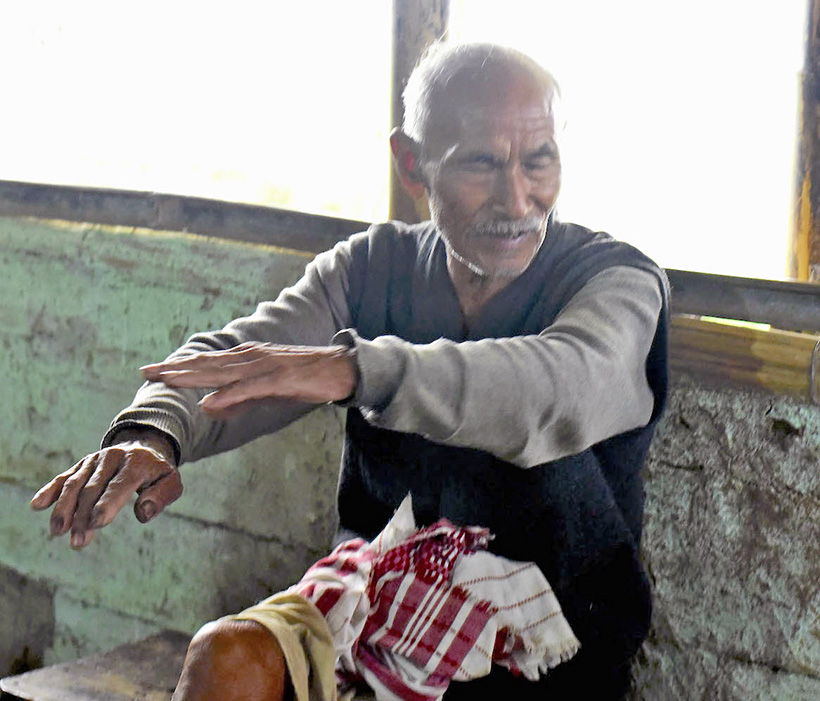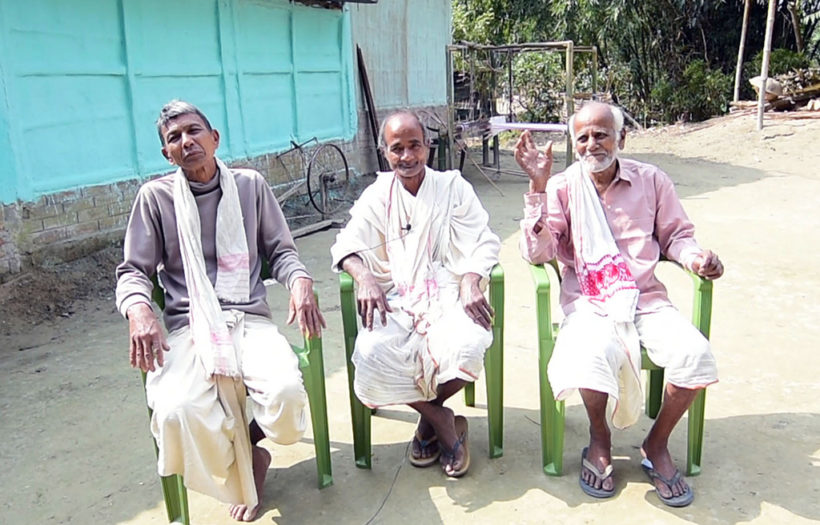The interviews in this article were conducted face-to-face as part of field research between October and December 2021.
By Moushumi Basu
The northeastern Indian state of Assam is more affected by climate change than any other part of the country. When it comes to predicting the course of rivers, rainfall and floods, the observations of elders based on their traditional experiences and folk beliefs are still considered credible early warning systems in many villages, even when most villagers have access to smartphones and weather apps.
Udhab Borah, 28, was one of the first to start using smartphones in his home village of Sumoni Chapori in Jorhat district about five years ago. This gave him access to various weather apps. “Even though I scroll through the various forecasts on my mobile phone, or stop to listen to the announcements that are made on radio and television, I still think that the elders in my village are almost 80 per cent correct in their weather predictions,” he says.
Nature signals weather warnings
Sumoni Chapori village elders Narayan Neog, Gajan Borah and Pradeep Neog are known to accurately predict the arrival of rains, floods or cyclones. According to them, nature sends its signals to alert us of the coming calamities.
“Ame baan, kothale dhaan,” goes a popular adage, says Narayan. Translated, it means mango blossoms coming up in abundance heralds the floods of the year. And the appearance of abundant jackfruit on the trees indicates a good rice crop (less chance of floods) ahead.
“The animals around us are much quicker to sense changes in weather conditions and often behave strangely or erratically,” says Gajan. Years of observing some of these behavioural changes help them predict approaching natural calamities. He explains that, for example, if cows suddenly become restless, start running around and get out of control, it is a sign of impending rains and floods.
Pradeep further explains a popular belief based on the behaviour of cows at dawn, during the auspicious Goru Bihu (festival dedicated to the care and worship of cattle). The head of the household enters the cowshed at dawn to bow to the cows. If he finds the cows standing still or restless, it is a sign that there will be a flood that year.
Worse still, if there are dark (black) cows that are restless and nervous, this indicates that flooding may be more severe than normal. However, on rare occasions, if the cows are sleeping or lying on the ground, this is a time to rejoice, as it means that there will be no floods that year.
But with the vagaries and effects of climate change becoming increasingly unpredictable, they admit that even the animals’ behaviour is becoming unreliable.
The villagers further believe that if the water level of the Brahmaputra River rises on a particular Ambubachi day (another sacred June occasion observed by the entire state), there will be floods for the rest of the year. On the other hand, if the river does not rise on that day, the floods would be less severe.
According to them, the uninterrupted croaking of frogs or the sudden appearance of traces of small ants on the ground also warn of heavy rains and floods. In addition, if water bodies have no fish or fewer fish during the early part of the rainy season (April-May), there could be flooding that year.
“The behaviour of vultures, which are rarely seen, also helps us forecast storms and cyclones,” says Rajib Morang of Majdolopa village in Golaghat district. Vultures are known to build their nests high up in trees, he explains. They may be able to sense the approaching cyclones in advance and, consequently, choose trees in safe places to build their nests. Therefore, the ease with which their nests are seen indicates that there is less chance of cyclones.

Rajib Morang, an elder from Majdolopa village in Golaghat district, explains his way of predicting the weather. Photo by Moushumi Basu.
Distant mountains and weather conditions
Rajib further points out that the thick dark grey clouds covering the sun and the sky, enveloping the horizon and distant hills, are sufficient warnings of heavy rains in the highlands of neighbouring Arunachal or Nagaland states.
“We also observe the wind direction, the height of the clouds and their proximity to the mountains. This gives us an idea of the state of rainfall and flooding in the higher ranges,” he says. In this way, they can estimate the time when rainwater will come down the hills and flood the villages.
Community members living in the hills also let them know when there are heavy rains that can cause flooding. “We are usually warned about 24-36 hours in advance and this helps us decide in advance what preparedness measures we should take – whether we can cope from our homes or we would have to run away with our belongings and livestock to higher ground near the dykes,” he says.
Preservation methods
These folk beliefs have been passed down as oral traditions among villagers for generations. However, in an effort to preserve them, some enthusiastic and educated young people in some villages are also documenting them. Non-profit organisations such as the Balipara Foundation are interviewing and videotaping village elders to preserve their folk beliefs and traditional knowledge.
“It may be difficult for us to establish these beliefs scientifically, but they have been proven to be at least 75 to 80 per cent correct,” says Ratul Mahanta, a professor of economics at Gauhati University, who works on climate issues with indigenous communities. According to him, these local communities have been living on the banks of the Brahmaputra River for generations. By coexisting with the local ecosystem and biodiversity, they have observed the behaviour of the flora and fauna and adapted to the changing natural phenomena.
“All these aspects together have shaped their local customs, indigenous knowledge and traditional wisdom, which enable them to predict the coming weather quite accurately,” he says. Most importantly, he says, the elders’ predictions help community members prepare in advance for upcoming weather disturbances.
Note: Research and reporting for this article was supported by the National Geographic Society as part of a grant to tell stories about the impact of climate in the Himalayan region.












